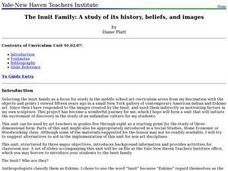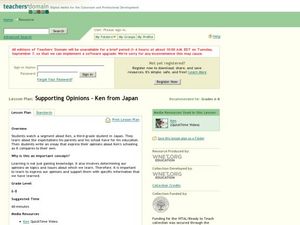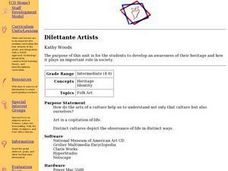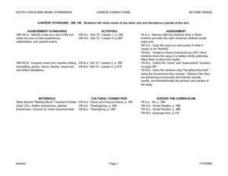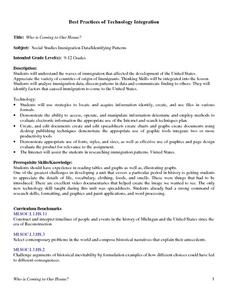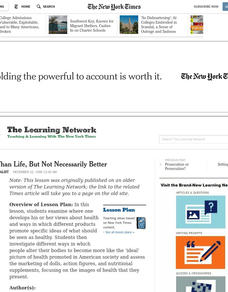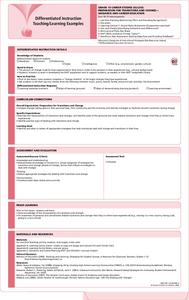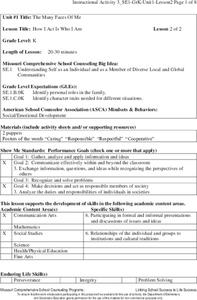Curated OER
Life in a Coal Patch
Young scholars study life in a coal patch town. In this American History instructional activity, students read material about life for coal miners and their families. They answer questions, create a poster, and complete a creative...
Curated OER
Life and Death in the Camps
Students state the difference between death camps and concentration camps used during the Holocaust. Using primary source documents, they summarize what life in the camp was like. They describe the final solution used by the Nazis.
Curated OER
Vanished Occupations: Life on an Iron Plantation
Learners analyze photographs to understand life on a plantation. For this vanished occupations lesson, students examine why iron plantations were created and what natural resources were needed to make iron. Learners compare the...
Curated OER
The Inuit Family: A study of its history, beliefs, and images
Learners study the Inuit in terms of their geographic location and its influence on their way of life. They investigate Inuit imagery as a reflection of their belief system and focus on the objects of the Inuit to introduce...
Curated OER
Supporting Opinions - Ken from Japan
Middle schoolers write a compare and contrast essay. In this writing skills lesson, students learn about life in Japan through a video of a Japanese third grader. Middle schoolers use notes written on the video to write a...
Curated OER
Dilettante Artists
Students investigate their personal heritage. They research and record iand organize nformation in journal notes. Students create folk art using a variety of techniques and media.
Curated OER
living in our family
Students compare a day in the life of a young person in one Asian country (India, Indonesia, Philippines, Thailand, or Vietnam) with a day in their own lives. The focus of this unit of work is on families, and students are required to...
Curated OER
Music And The Related Arts / Fiesta
Second graders investigate the concept of a celebration through the experience of music and culturally relevant conversation. They have a class discussion about thankfulness and tie it the tradition of celebration. Then students listen...
Curated OER
Work and Play: Today and Yesterday
First graders investigate the concept of play and work. They use primary and secondary resources in order to find the information of comparing the concepts in the context of the past to present day. Students brainstorm to find the...
Curated OER
We and Thee
Students examine class structure. For this diversity education lesson, students discuss stereotypes within their school as an introduction to Shakespeare's Romeo and Juliet. After students have read the play and discussed social class...
Curated OER
The Story of How Deerfield Came to Be
Eleventh graders explore how the native peoples had lived in the Connecticut Valley for nearly 10,000 years, prior to the English settlement and how their culture and life ways were markedly different from that of the English settlers.
Curated OER
Who is Coming to Our House?
Pupils examine waves of immigration that affected the development of the United States, appreciate variety of countries of origin of immigrants, analyze immigration data, discern patterns in data and communicate finding to classmates,...
Curated OER
Children Around the World: School and Daily Life
Students research what it is like to go to school in different countries around the world.
Curated OER
Bigger Than Life, But Not Necessarily Better
Pupils evaluate images of health in American society, then students examine where one develops his or her views about health.
EduGAINs
Preparation for Transitions and Change— Guidance and Career Education
Every hopeful in your class has gone through some kind of life change, from parents' divorce to a death in the family to moving up into another grade. Encourage them to discuss these changes, the skills they used and acquired...
Edible Schoolyard
Pan de los Muertos
Accompany instruction and the celebration of El Dia de los Muertos with a loaf of Pan de los Muertos. Here, scholars measure ingredients precisely to create tasty bread, write a remembrance for someone who has...
Curated OER
Finding Meaning in the Badge
Children who are three to five years old study two rank badges from the Qing dynasty to develop an understanding of social rank, language skills, and symbolism. The instructional activity is discussion-based and requires learners to...
Curated OER
Human Cloning: Is it Biological Plagiarism?
Is cloning good or harmful? Help your class understand the risks and benefits as they read, research, and discuss human cloning. Individuals form teams, research information, and present to the class before concluding with an in-depth...
Missouri Department of Elementary
An Apple a Day
Three apples—green, red, and rotten—exemplify character traits, negative and positive. Following a discussion about the classroom community, scholars complete an apple-themed worksheet that challenges them to read each trait, color it...
National Gallery of Canada
The Body Tells Its Story
Incorporate sculpture into your art curriculum. To start, pupils discuss the artistic process and topics of marginalization. With the discussion in mind, individuals select images to inspire sculptures of people that they will present to...
Peace Corps
Community
What is a community? Find out with a lesson that sheds light onto the different types of communities—school, local, and global. Scholars read informational text detailing the life of a young girl from Cape Verde and take part in a...
Missouri Department of Elementary
How I Act Is Who I Am
A lesson centers itself around the topic of family roles. A whole-class discussion uses puppets and posters to go in-depth into the following character traits; caring, responsibility, respect, and cooperation. The discussion closes with...
Global Oneness Project
Highways and Change
What is the cost of change? Roberto Guerra's photo essay "La Carretera: Life and Change Along Peru's Interoceanic Highway" asks viewers to consider the impacts of the 1,600 mile-long highway through Peru and Brazil that connects Pacific...
Penguin Books
A Teacher’s Guide to the Signet Classics Edition of Mary Shelley ’s Frankenstein
Contrary to popular belief, the monster's name in Mary Shelley's Frankenstein is not Frankenstein. A teacher's guide for the novel helps readers make sense of key details in the text, define vocabulary words, and discuss prominent...



